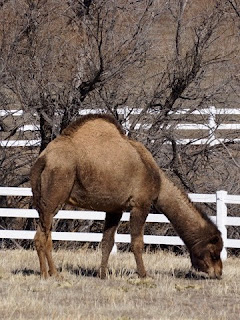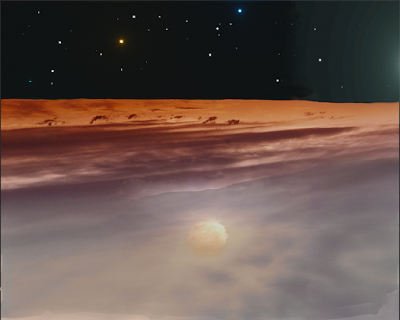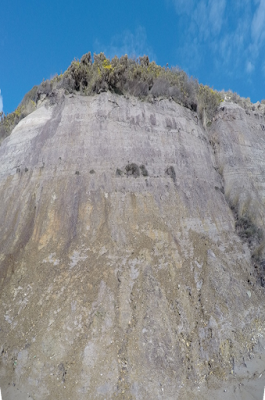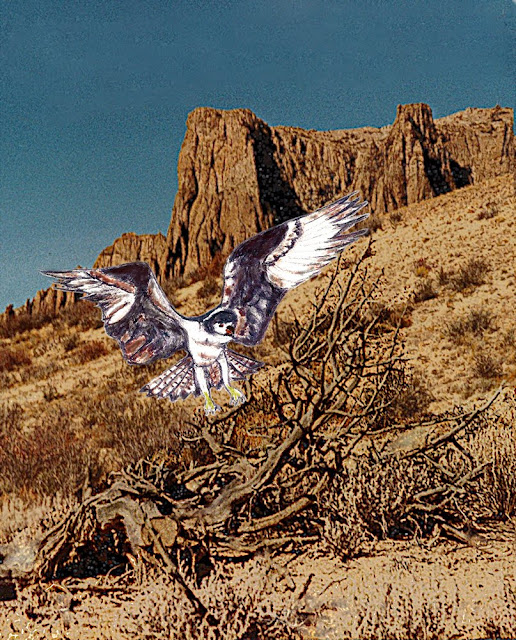Jim Richardson,
National Geographic photographer, urges photographers to think of landscape photographs they are about to shoot as if they were settings for plays.* That set me to thinking of broader applications for that principle: I wanted to apply it to pictures we already have.
Do you have photographs or sketches of landscapes that are accurate, but that just aren't ‘special’? Too good to throw away, not good enough to frame? Perhaps you have a collection of picture postcards from past trips stored in a box somewhere. I certainly have all of those. I got out a few while I thought about what to say in this post.
I took the picture above late in the day, looking westward. The color is accurate, I did not use a colored filter. I have always liked the picture, but had never decided what to do with it. It seemed a good place to start the current experiment. Because I wanted to try several scenarios with my picture, I made a couple of copies before I moved to the next step. J.D. took one for his own use. We decided to each do the project, but separately, choosing our own themes. J.D. will chime in with comments on his own results as we go along.
 |
| Camel, photo by J.J. |
Much of western Colorado, where our picture was taken, is semi-desert. It is not a sand desert, but dry grassland with some rocky areas. The picture certainly said
desert to me. I determined it would be the backdrop for a desert scenario. And what more appropriate desert animal than a camel?
“But a
camel in
western Colorado?”, you scoff. Well, truth is often stranger than fiction. In 1855, Jefferson Davis (remember him from the Civil War?) was the Secretary of the U.S. War Department. He spent $10,000 to import camels to carry supplies and mail between remote western military posts. The endeavor worked well but was broken up by the Civil War, when most of the animals were auctioned off, killed, or escaped. At least one became the source of a legend, said to be 30 feet tall, to eat grizzly bears, and to vanish when in plain view. (Look up “camels in the Western U.S.”, and also look for a
Smithsonian article on the Legend of the Red Ghost — great reading!) I decided to do a detailed color drawing on watercolor paper to depict the
Legend of the Red Ghost. One story was that the camel carried a macabre burden — a skeleton wrapped in canvas, strapped and roped to the camel's back.
The image was drawn in colored pencil, graphite and charcoal. I sprayed it with fixative (hair spray will do, but practice first to get distances and amounts of spray correct; it is better to do this outside on a warm, calm day). I cut the figure out carefully with small, very sharp scissors and put it in place on the photograph. I used sketches, but you might prefer to use other photographs.
 |
| Legend of the Red Ghost paste-up by Annake |
J.D.: Over the winter holidays, I began to learn to use a much more powerful image editing program in order to meet the increasing technical demands of the work at Annake’s Garden; so, when Annake proposed this exercise, I decided it was a good time to see how far I’d learned to push the boundaries of what I could do with digital images. First I turned the picture upside down and backwards – and got an image that looked a lot like the sea at a sandy beach, about as far from a desert scene as you can get. Being an ornery and contrary sort of creature, I figured I would see how many element of this image I could turn into their opposites.
 |
| "Moonlight on Dunes," digital graphic by J.D. |
Without getting into the specifics of how I used the software, this is what I did: turned sky into water and sand, mostly by stretching the image horizontally and squashing it vertically; turned the ground into night sky by pasting in a strip of the same almost-black color, then sprinkling in some fake stars; turned the sun into a reflection of the moon by laying a mostly transparent image from a different source over it, then adding a little glare effect at the right edge to suggest an out-of-frame moon rising. Everything else was just fine tuning the intensity of the colors, contrast, and sharpness to give the impression of a photograph taken at night.
This all may sound like mysterious high-tech digital wizardry, but there is nothing here that can’t also be done in an analog photographer’s darkroom (although it might take considerably more time and expense!)
ANNAKE: Now suppose you had a copy of the photograph we worked on. What would you do with it? Ask yourself some questions:
- Do I need to turn the photo upside down? Change a horizontal picture to a vertical one or the reverse? Crop the photo (cut off parts of it)? Cover up or take out something? Change my perspective (point of view)?
- What kind of story would I like this landscape to tell? Adventure? Romance? History? Mystery? Fantasy? Science fiction (remember J.D.'s "Early Morning Frost...” on Mars)? Horror? Comedy? Tragedy? Natural history?
Once you have decided what kind of story you want to tell, ask yourself if the picture you are considering can help you tell that kind of story. If the answer is "Yes", then ask yourself
how the picture can help.
- Does it suggest a particular place? A particular period of time?
- What sort of people might live here or have lived here in the past?
- Is it the habitat of a particular animal? Alive or extinct? Real or mythical?
- What interesting objects might have come to rest here? Is it an extraterrestrial place? In the sky? Under the ground?
 |
| Cliff face (rock wall**) |
Each decision will clarify your story in your mind. You will begin to ‘flesh out’ your narrative. Then decide what scenery, props, and cast members you need to introduce into the photo to make your story come to life. You might have a picture of a steep rock wall. Are you going to show a family of mountain goats descending the wall? Climbers free-climbing or ascending on ropes? A hang-glider swooping away from it? A helicopter hovering in front of it? Choose your characters and props carefully.
Now, how are you going to get your props and characters onstage?
- Are you going to cut parts out of other photographs and glue them to your background?
- Are you going to stand the background up and place cutouts or small model figures in front of it? Make a diorama out of it?
- Are you going to glue or paint your characters and/or props on a clear plastic overlay?
 |
| Another 35mm photo by Annake |
This photograph is also one of mine and was done with no color filters. Not desert this time, but certainly dry grassland and open woodland. There's no mystery involved this time. It is a simple natural history scene that could easily have happened. J. D. asked for a big raptor alighting on the pile of branches, and that is exactly what I gave him.
The hawk was done in the same way as the camel and applied to the photograph. It is a kind of hawk known to make its nest of sticks. The picture was cropped to take out "clutter".
 |
| Desert hawk paste-up by Annake |
J.D.: Since Annake used my best idea for this photo, I struggled to come up with anything else interesting. In the end, I just squashed the perspective enough so that I could create sufficient foreground to put in some stock creepy elements. The skull and spider are cut-&-paste from public domain photos available online, and the burrow with glowing red eyes under the pile of sticks is pretty much the same set of effects I used for the night sky in the beach scene above. I don’t really have a story for this image, but if it inspires one for you drop us a line and let us know.
 |
| J.D.'s silly/spooky landscape |
ANNAKE: This post is the result of my musings. It is not just for those of us who paint landscapes, photograph them, or portray them in needle arts. It is for those who have photos, slides, or sketches they have always meant to organize and "do something" with, for those who collect picture postcards, and for those who just like to make something new out of something old that might otherwise be discarded. (If I missed anyone, it probably applies to you, too.) Have fun!








 This post by Annake's Garden is licensed under a Creative Commons Attribution-NonCommercial-ShareAlike 3.0 Unported License.
This post by Annake's Garden is licensed under a Creative Commons Attribution-NonCommercial-ShareAlike 3.0 Unported License.



No comments :
Post a Comment
Post a New Comment Below -- We Love Feedback !!!